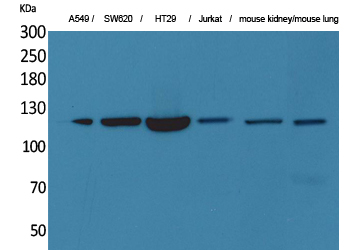
| WB | 咨询技术 | Human,Mouse,Rat |
| IF | 咨询技术 | Human,Mouse,Rat |
| IHC | 1/50-1/100 | Human,Mouse,Rat |
| ICC | 技术咨询 | Human,Mouse,Rat |
| FCM | 咨询技术 | Human,Mouse,Rat |
| Elisa | 1/10000 | Human,Mouse,Rat |
| Aliases | Prominin-1; Antigen AC133; Prominin-like protein 1; CD133. |
| Entrez GeneID | 8842 |
| WB Predicted band size | Calculated MW: 97 kDa; Observed MW: 100 kDa |
| Host/Isotype | Rabbit IgG |
| Antibody Type | Primary antibody |
| Storage | Store at 4°C short term. Aliquot and store at -20°C long term. Avoid freeze/thaw cycles. |
| Species Reactivity | Human,Mouse |
| Immunogen | The antiserum was produced against synthesized peptide derived from the N-terminal region of human PROM1. AA range:41-90 |
| Formulation | Purified antibody in PBS with 0.05% sodium azide,0.5%BSA and 50% glycerol. |
+ +
以下是3篇关于CD133抗体的代表性文献(简要概括):
1. **文献名称**:*Identification of a cancer stem cell in human brain tumors*
**作者**:Singh SK, et al.
**摘要**:首次通过CD133抗体鉴定出胶质母细胞瘤中的CD133+细胞亚群,证明其具有干细胞特性(自我更新和致瘤性),为肿瘤干细胞研究奠定基础。
2. **文献名称**:*CD133 antibody-targeted therapy for colon cancer*
**作者**:Todaro M, et al.
**摘要**:利用CD133抗体偶联药物靶向结直肠癌中的CD133+肿瘤干细胞,在体外和小鼠模型中显著抑制肿瘤生长,提示CD133作为治疗靶点的潜力。
3. **文献名称**:*CD133 expression correlates with chemo-resistance in hepatocellular carcinoma*
**作者**:Zhu Z, et al.
**摘要**:通过CD133抗体检测发现肝癌组织中CD133+细胞比例与化疗耐药性正相关,提示CD133可作为预后标志物及耐药机制的研究靶点。
**备注**:以上文献可在PubMed通过标题或DOI检索原文(例如PMID: 15183675)。如需更近期研究(2020年后),可补充说明。
CD133 (Prominin-1) is a transmembrane glycoprotein widely recognized as a marker of stem and progenitor cells across various tissues, including hematopoietic, neural, and epithelial systems. First identified in the 1990s, CD133 gained prominence due to its selective expression on undifferentiated cells with self-renewal and differentiation capacities. The CD133 antibody, typically targeting specific extracellular epitopes (e.g., AC133 epitope in humans), was developed to isolate and characterize these cell populations for research and therapeutic purposes. Structurally, CD133 contains five transmembrane domains and two large glycosylated extracellular loops, contributing to its antigenic properties and functional roles in cell membrane organization.
In oncology, CD133 antibodies are extensively used to investigate cancer stem cells (CSCs), as its overexpression correlates with tumor initiation, metastasis, and therapy resistance in cancers like glioblastoma, colon, and liver carcinomas. However, debates persist regarding its specificity, as post-translational modifications (e.g., glycosylation) and splice variants may affect antibody binding, leading to inconsistent experimental outcomes. Commercially available clones (e.g., AC133. W6B3C1) vary in recognizing distinct conformational epitopes, necessitating careful validation for specific applications.
Beyond research, CD133 antibodies hold potential in clinical diagnostics and cell-based therapies, such as enriching stem cells for regenerative medicine. Despite challenges in standardization, ongoing studies aim to clarify CD133's biological functions and refine antibody-based tools for precision medicine.
×